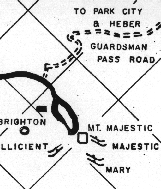Utah Centennial Studies

Hunt For the Blind Miner's Mine Packet A
BIG COTTONWOOD CANYON
 Besides being the scene of unfortunate accidents,
the canyon was sometimes the place where fortunate accidents took place.
John Maxfield and his brother, Robert, father of R. D. Maxfield, Jr.,
were bringing logs out of Mill A Gulch (6.6) to the sawmill they had built
at its mouth when they uncovered a vein of ore. They filed for and staked
claims on what came to be known as the Maxfield Mine.
Besides being the scene of unfortunate accidents,
the canyon was sometimes the place where fortunate accidents took place.
John Maxfield and his brother, Robert, father of R. D. Maxfield, Jr.,
were bringing logs out of Mill A Gulch (6.6) to the sawmill they had built
at its mouth when they uncovered a vein of ore. They filed for and staked
claims on what came to be known as the Maxfield Mine.
The Maxfields were primarily lumbermen, and in their situation what would you do? In that day you might have traded the claims for a wagon, a team of mules, and $80.00 cash, as they did, which certainly must have seemed a reasonable deal. The buyer, a Mr. Price, sold it once more in 1879, and the Maxfield Mining Company was incorporated. By 1906, more than $1,000,000 in silver had been taken from the mine. Had the Maxfields been able to foresee this, it might have convinced them to change their occupation.
Tragedy was also part of the area. During this time, a boarding house had been built at the mouth of the Gulch and was occupied by a woman and three children. An avalanche came down the mountain and killed them all, carrying the building across to the south side of the canyon. The sawmill was also destroyed and was never rebuilt.
Avalanches were numerous, and several lives were lost to them over the years. A man named Taggett worked for Alvin Green and built a cabin for his family on a flat near Mill D South Fork. Robert Maxfield advised him of the snowslide danger that was common in the area and suggested that he move his family during the winter months. The warning wasn't heeded and an avalanche killed all of them.
None of this deterred the Argenta (7.0) from springing up as a result of the work in the Maxfield Mine and the nearby Colly Varden Mine. On July 27, 1872, a group of miners met to choose a name for the town and to pass upon a resolution that permanent settlers be given a free lot. Argenta appropriately means silver. In a few short years, the town, located on the flat to the south side of the creek, had a population of 200 people, a voting district, a post office, a store, and a boarding house.
There was also a laundry run by a Chinese man who was always the butt of the miners' jokes. Not being able to take it any longer, he retaliated in the best way he knew -- by starching their underwear until it could stand up by itself. It surely curtailed either the jokes or his business.
Just about as rapidly as it had appeared, Argenta began to disappear in 1892. The last cabin was torn down around 1920.
To some, mining was such a part of life that even the loss of sight didn't stop them. In more recent times, James L. Newman was blinded by a blast in about 1929, but continued to operate the mine, extending it back 1,600 feet in the following 30 years. The Newman Mine (7.2) is located just above the Argenta townsite above the south side of the highway.
U.S. Department of Agriculture Forest ServiceIntermountain Region
Wasatch National Forest


 UTAH EDUCATION NETWORK
UTAH EDUCATION NETWORK

 Justin
Justin Braxton
Braxton Dani
Dani Kayla
Kayla Katie
Katie Rob
Rob Val
Val
